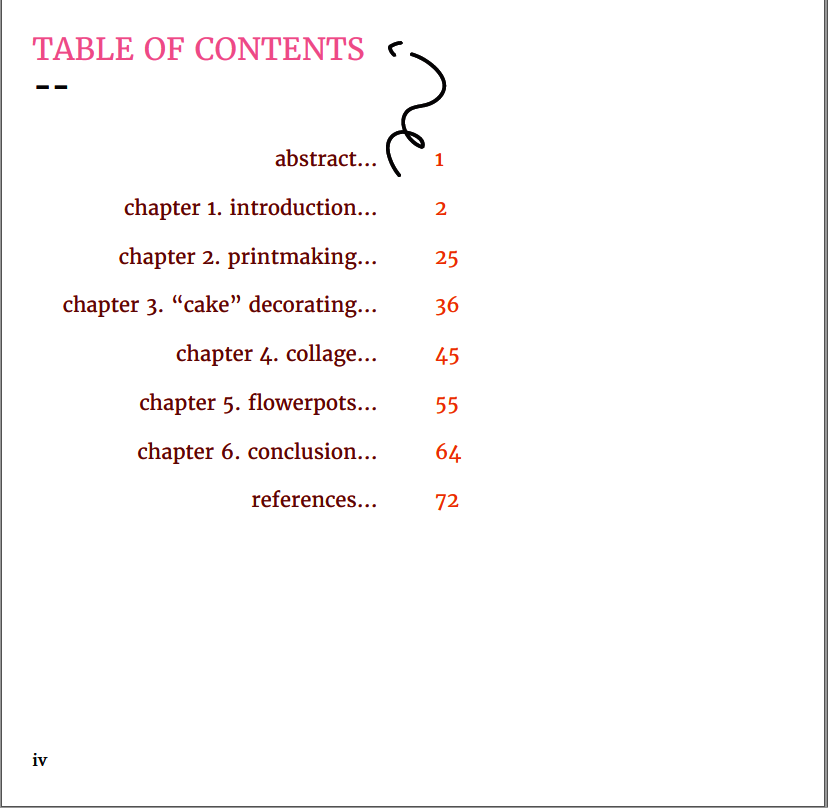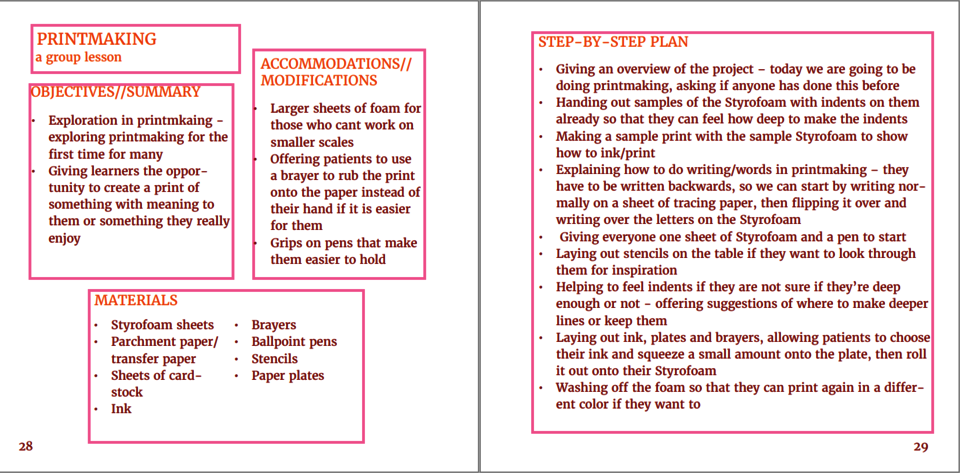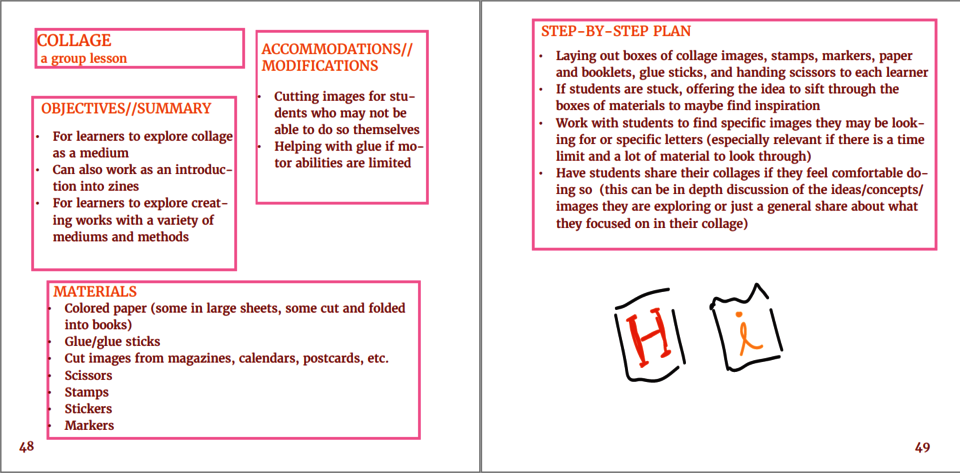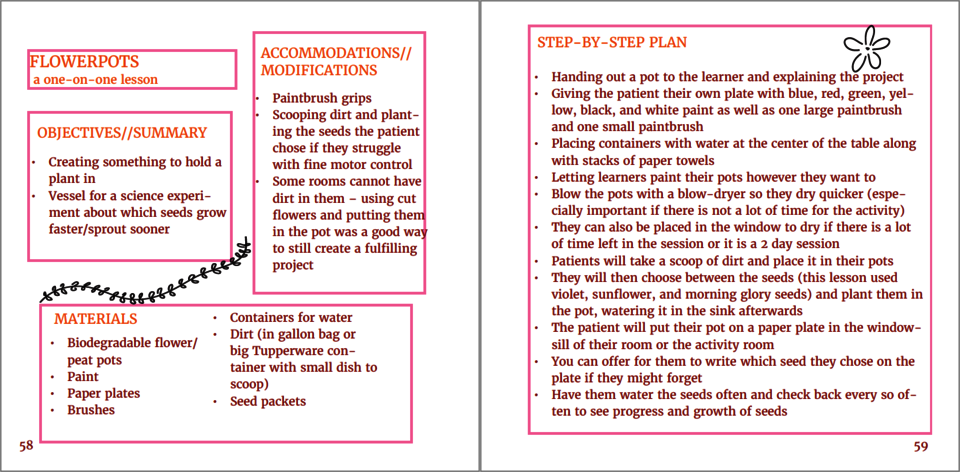Phoebe Strobino
Artful Healing: Exploring Creative Expression and Play in Children's Hospitals
This thesis explores the role and accessibility of creative expression and play in children’s hospitals, and the impact these ideas have on patients. I explored these ideas through teaching four lessons at Hasbro Children’s Hospital in Providence, Rhode Island. Two of these lessons were taught in group sessions, and two were taught in one-on-one sessions, with participants ranging in age. Following an introduction to each lesson, I provide the plan itself along with general observations and reflections on teaching. Due to the nature of the setting, information is kept purposefully broad throughout my observations in order to respect the anonymity of the children I taught. Each of these lessons explores a different role of artmaking through the lens of creative expression and play in the children’s hospital.
Image

Cover of thesis book: Artful Healing: Exploring creative expression and play in children's hospitals
Art Making in Children's Hospitals?
My thesis work considers the role of the arts in children’s hospitals. Within this larger framework my thesis explores the accessibility of arts programing in the hospital: if the programs are adaptable for all abilities and age groups, whether they cater to in-patients or out-patients, and if there are opportunities to involve the family in the activity as well. I am interested in exploring how creative expression and play can be fostered in environments where they are not usually found, like the children’s hospital. Following this idea, my thesis also explores the impact that these programs of creative expression and play have on patients.
I became interested in this topic specifically after seeing the impact of this type of work for patients and their families firsthand in my past intern experience at Boston Children’s Hospital. During that time, I discovered the importance of adding in an element of childhood in situations where kids might not get to act like children. Keeping elements of creativity and play alive for kids who may not get to experience it in their day-to-day life seemed to have a meaningful impact on patients and their families. It is an important area of art education in that this type of work provides a brief distraction and almost a sense of normalcy for children and families. Further, this type of creative exploration gives kids the opportunity to be kids, which is important for emotional well-being.
This type of art making in this specific setting is not normally considered when thinking about art education. The majority of literature published in the field relates more to art therapy than to just art making, creative expression, and play. While art therapy is a fantastic route of art making in children’s hospitals and health settings, sometimes just giving kids the opportunity to create, explore, and play can also provide meaningful experiences. Art making in these settings act as a non-traditional type of art education. Teaching of art in children’s hospitals is very open ended and patient driven.
Image

introduction chapter page
Methodology and Structure
I answer my research question through a combination of methods. Each chapter starts with an introduction to the lesson, then a detailed lesson plan created for the specific setting of hospital art making. Of the four lessons total, two are created with group settings in mind, and two designed for one-on-one artmaking sessions. The lessons center around ideas of material exploration and fostering a playful environment while including accommodations for the specific setting.
I had the opportunity to facilitate these lessons during artmaking sessions at Hasbro Children’s Hospital. As a result of my methods, my “data” takes the form of observations from the lessons. I also include my reflections on the lessons and observations as a further exploration of the “data.”
Image

Table of contents outlining the layout of the book
Research Findings
I found that my research does answer my general question about the role and accessibility for creative expression and play in children’s hospitals, as well as the impact this has on patients. I observed the impact these making sessions had on patients, at least in the immediate aftermath and while partaking in the artistic process. I noticed a change in makers in terms of their creative confidence, especially if I were working with them week after week. Makers went from being hesitant to even start a piece in case it didn’t turn out “right,” to being eager to create the next project and explore more materials. Through the artmaking process many children opened up as well, often going from being very quiet when the session started to asking me to stay longer and do more with them when the project was done.
Through the four lessons I taught I derived several big ideas related to the role of creative expression and play in children’s hospitals, along with reflections on the accessibility of these practices. In the printmaking lesson, I explored how art can be used as an outlet for creative expression of interests and passions as well as how artmaking sessions can be used as a playful exploration of materials and processes. In the “cake” decorating lesson I again explored how art acts as a playful exploration of materials, this time looking at unconventional materials for the setting. The collage lesson explored creative expression of interests and personality as well as playful exploration of mediums and materials, and creative exploration as an expression of choice. Lastly, the flowerpot lesson examined creative expression and play through intersections of art and science, and artmaking as a continuous learning opportunity.
When considering these ideas together under the lens of my research question, I determined that the role of creative expression and play in children’s hospitals varies depending on the specific art making activity.
Lesson Plans
- Architecture
- Ceramics
- Design Engineering
- Digital + Media
- Furniture Design
- Global Arts and Cultures
- Glass
- Graphic Design
- Industrial Design
- Interior Architecture
- Jewelry + Metalsmithing
- Landscape Architecture
- Nature-Culture-Sustainability Studies
- Painting
- Photography
- Printmaking
- Sculpture
- TLAD
- Textiles




